 Weird Stuff
Weird Stuff  Weird Stuff
Weird Stuff  Our World
Our World 10 Ways Your Christmas Tree Is More Lit Than You Think
 Movies and TV
Movies and TV The 10 Coolest Stars to Set Sail on The Love Boat
 History
History 10 Things You Didn’t Know About the American National Anthem
 Technology
Technology Top 10 Everyday Tech Buzzwords That Hide a Darker Past
 Humans
Humans 10 Everyday Human Behaviors That Are Actually Survival Instincts
 Animals
Animals 10 Animals That Humiliated and Harmed Historical Leaders
 History
History 10 Most Influential Protests in Modern History
 Creepy
Creepy 10 More Representations of Death from Myth, Legend, and Folktale
 Technology
Technology 10 Scientific Breakthroughs of 2025 That’ll Change Everything
 Weird Stuff
Weird Stuff Ten Bizarre Facts About The Doge Meme
 Our World
Our World 10 Ways Your Christmas Tree Is More Lit Than You Think
 Movies and TV
Movies and TV The 10 Coolest Stars to Set Sail on The Love Boat
Who's Behind Listverse?

Jamie Frater
Head Editor
Jamie founded Listverse due to an insatiable desire to share fascinating, obscure, and bizarre facts. He has been a guest speaker on numerous national radio and television stations and is a five time published author.
More About Us History
History 10 Things You Didn’t Know About the American National Anthem
 Technology
Technology Top 10 Everyday Tech Buzzwords That Hide a Darker Past
 Humans
Humans 10 Everyday Human Behaviors That Are Actually Survival Instincts
 Animals
Animals 10 Animals That Humiliated and Harmed Historical Leaders
 History
History 10 Most Influential Protests in Modern History
 Creepy
Creepy 10 More Representations of Death from Myth, Legend, and Folktale
 Technology
Technology 10 Scientific Breakthroughs of 2025 That’ll Change Everything
10 Little-Known Facts About Pumpkins
Whether October or November, pumpkins are a beloved symbol of autumn. In October, they are popular as jack-o’-lantern decorations, and massive numbers of pumpkins are grown for just this purpose. In November, they are favored for the pumpkin pies of Thanksgiving and their long tradition as an American food.
Though botanically a fruit, pumpkins are one of the most beloved vegetables. Here are some little-known facts (and dark secrets) about pumpkins.
10 When A Pumpkin Isn’t A Pumpkin
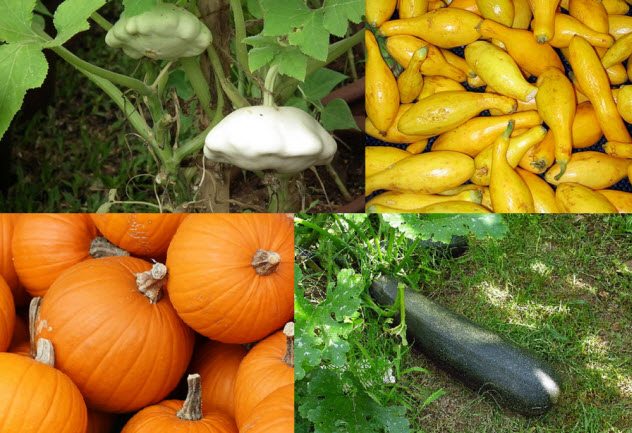
Pumpkin plants are in the Cucurbitaceae family, which includes melons, cucumbers, and squash. While pumpkins are often thought to be separate from squash, they are, in fact, a type of squash.[1] “Pumpkin” is neither a specific species nor a valid botanical classification. Whether a squash is called a “pumpkin” depends on its appearance and the use of its fruit.
A pumpkin is typically round with smooth, hard, slightly ribbed, deep yellow to orange skin. The term “pumpkin” applies mostly to three or four closely related species: Cucurbita pepo, C. moschata, C. maxima, and C. argyrosperma. The latter was once called C. mixta, and some sources claim it has varieties called pumpkins. Other sources do not make this claim, but the distinction is ultimately pointless.
Many cultivars in those species do not look like jack-o’-lanterns at all. For example, both the butternut squash and the Long Island cheese pumpkin (a squat, pastel-orange, jack-o’-lantern type) are in C. moschata. The species also contains the Dickinson pumpkin, the pumpkin of choice for the “canned pumpkin” producer Libby’s. Though the name “pumpkin” might bring to mind jack-o’-lanterns, the Dickinson pumpkin looks like a butternut squash.
9 Squashes For Pumpkin Pie
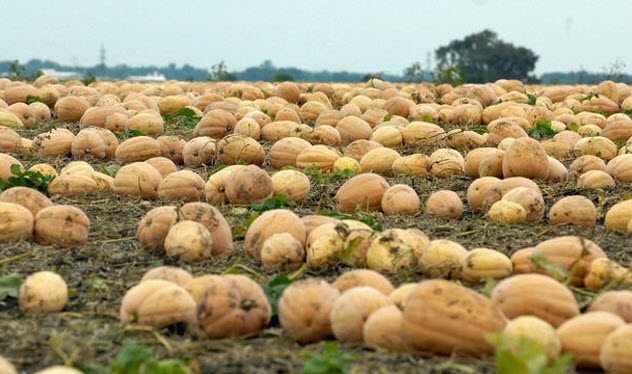
When people think of “pumpkin pie,” they expect it to come from the jack-o’-lantern type. However, that’s usually not true for canned pumpkin pie filling. Instead, the Dickinson pumpkin (which looks like a butternut squash) and the butternut squash itself are popular.
When pie filling does not contain the jack-o’-lantern pumpkin, people may conspiratorially say that canned pumpkin does not contain pumpkin at all.[2] The whole argument is a fallacy as pumpkins are not botanically distinct from squash.
So why was Libby’s using a butternut squash look-alike for canned pumpkins?
The Dickinson cultivar has several advantages over other varieties. It has more flavorful flesh per pound, a thinner rind, fewer seeds, and a smaller hollow part. On the other hand, the field pumpkin, used for jack-o’-lanterns, is usually ill-suited for pumpkin pie. Though the jack-o’-lantern pumpkin can be made into pies, the cultivar is not really intended for human food. (However, this depends on the cultivar. The Triple Treat, for example, is good for both carving and pies.)
Since 1938, the FDA has told canners that it will not initiate regulatory action purely because “pumpkin” is used on the labels of canned products made from golden-fleshed sweet squash or mixtures of such squash with field pumpkins. Without evidence that the name deceives or misleads customers, the agency sees no reason to change the policy.
However, it is possible to make a good pie from something with a jack-o’-lantern-like appearance. Pie pumpkins are a class of pumpkins bred to be eaten. They are smaller, sweeter, and denser than their larger, carving-bound relatives.
8 Prehistoric Pumpkins
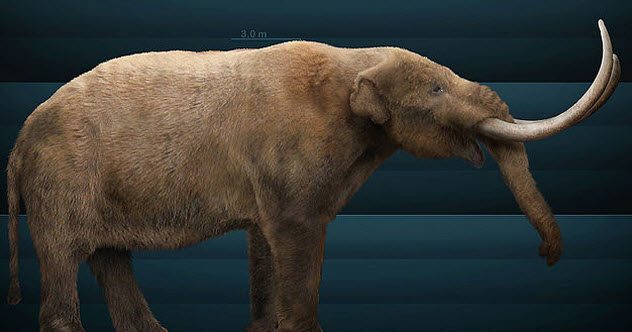
Today, pumpkins (and “squash”) are a popular crop grown in several states. But humans were not the first to eat pumpkins and spread their seeds. The mastodon—an ancient, woolly mammoth-like prehistoric mammal—once spread squash seeds. The evidence lies in the squash seeds found in their fossilized dung.[3]
Wild squashes were once common in North America. As weedy plants, they thrived in the disturbed landscape of giant mammals. The chemical cucurbitacin made the flesh of their fruits toxic and bitter-tasting.
The plant’s bitterness was a natural defense against the rodents and small herbivores that would have eaten its seeds. Small mammals with diverse diets tend to have more bitter-receptor genes. Larger animals, such as elephants, have fewer, thus giving them less of an ability to taste bitterness.
Today, mastodons are extinct. In Africa, their closest living relatives, elephants, eat and spread several species of bitter squash. In the US, several zoos supply their elephants with pumpkins. The elephants smash and eat the pumpkins happily, much as their extinct wild relatives might have.
7 Image Problems
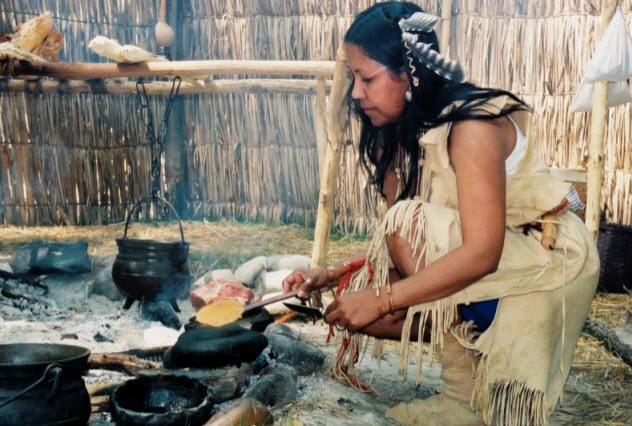
Originally, pumpkins had an image problem as an inferior foodstuff for the lazy, uncivilized, and poor.
Pumpkins were introduced to Europe at an early date from the Columbian Exchange. At some point in the 16th century, they were introduced to England from France.
Pumpkins grow easily, like weeds, and make large amounts of big fruit. They were a food that people could rely upon when things got tough, making them appealing to the rural poor.
Europe ridiculed the pumpkin and those who ate it as boorish and crude. Adding to this, pumpkins were cultivated by Native Americans, whom the New England colonists thought of as uncivilized. The association of pumpkins with the rural poor and American “savages” meant that colonists did not think highly of this food.
Nonetheless, New England colonists relied heavily on pumpkins when more desirable foods were unavailable. Indeed, their dependence led to a monotonous procession of pumpkin-based meals.[4] The colonists became defensive about their dependence on pumpkins, continuing to use them after other foods became available.
6 Odd Colors
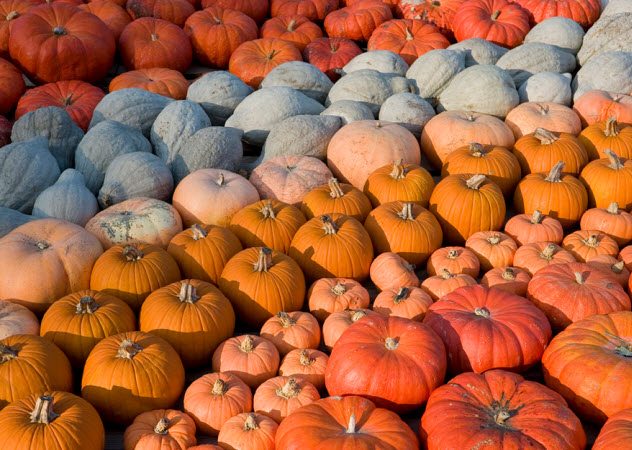
The standard pumpkin is a certain shade of orange. However, pumpkins do come in other colors, such as yellow, white, blue, and even pink.
White pumpkins are one of the more common alternative colors. They come in several cultivars, such as Baby Boo and Lumina. Once a novelty, they can now be bought at pumpkin patches and grocery stores and are only slightly more expensive. They offer a ghostly mystique and an alternative white “canvas” for painting. Though they look different from the standard jack-o’-lantern, it is only skin-deep: The flesh is orange (and edible) just like orange-skinned pumpkins.
The pie pumpkin Sunlight is yellow and also happens to be tolerant to powdery mildew disease. The Australian cultivar Jarrahdale is bluish-gray. The Galeux d’Eysines is pale pink with distinctive peanut-shell warts. These warts are actually sugar secretions, attesting to the pumpkin’s remarkably sweet flesh.[5] The Porcelain Doll pumpkin is also pale pink but lacks warts.
Even pumpkins not specially bred for unusual colors go through different color stages as they mature. Some varieties are yellow when immature and then turn orange. The giant pumpkin is typically yellow or white when immature and turns pink-orange to bluish-gray at maturity.
Pumpkin fruits infected with one or more viruses often fail to turn completely orange, with the green remaining as speckles or spots. Occasionally, this may be considered attractive, but pumpkins with severe virus symptoms are not usually marketable.
5 Animal Feed
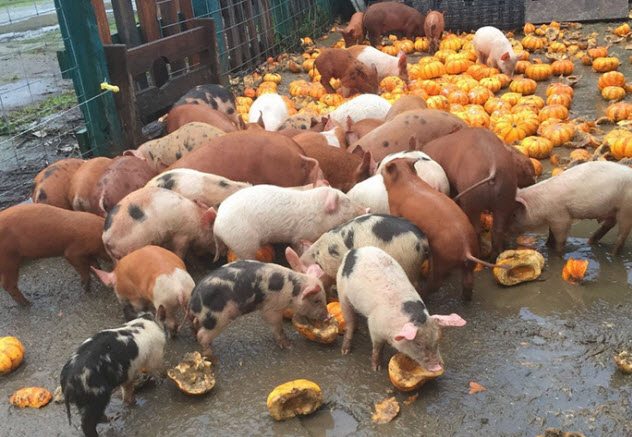
There is a long history of feeding livestock on pumpkins. Farmers growing pumpkins for jack-o’-lanterns may sell blemished or damaged pumpkins as livestock feed. Surplus pumpkins and unsold jack-o’-lanterns post-Halloween may be fed to livestock, too.
Farmers might also grow pumpkins specifically for livestock feed. For this purpose, carving varieties, such as the Connecticut Field, and the smaller of giant pumpkins, such as King Mammoth Gold, are used.
The pumpkins are chopped to the appropriate size of the animal being fed. Animals not familiar with pumpkins may take some time to get used to them.
Once, farmers thought pumpkin seeds would “dry up” cows (lower milk production) and be harmful to pigs. To avoid this, farmers would remove the seeds from pumpkins before giving them to livestock.
Pumpkin seeds are actually a good, nutritious feed because of their high protein and fat content. However, the idea that the seeds cause health problems has a kernel of truth.
While they do not dry up cows, only 14–18 kilograms (30–40 lb) of pumpkin should be fed to each cow per day due to the richness of the seeds. Furthermore, if pigs are fed solely pumpkin seeds, the animals experience indigestion due to the seeds’ fat.[6]
4 Versatility

For culinary purposes, the flesh of the pumpkin plant’s fruit gets most of the attention. However, its leaves, vines, flowers, and seeds are also edible.
The seeds (aka pepitas) are one of the most popular pumpkin-derived foodstuffs. They can be boiled, toasted, or dried like sunflower seeds or ground into pipian sauce.[7]
Pumpkin leaves are high in vitamin A and are a good source of calcium, vitamin C, iron, and protein. They can be steamed, boiled, panfried, or used in stews. Overall, pumpkin leaves have more food value than tinned peas.
The tips of the vines, or shoots, can be boiled, sauteed, or stir-fried. The hollow vines are favored throughout Asia, Africa, and Australia for their rich, meaty texture and earthy sweetness.
Pumpkin flowers are edible raw or cooked. They can be deep-fried, stuffed, sauteed, baked, or used in soups. Squash bees, the primary pollinator of pumpkins, tend to sleep inside pumpkin flowers. They may get trapped inside, much to the surprise of people preparing pumpkin blossoms.
3 Pumpkin Seed Oil
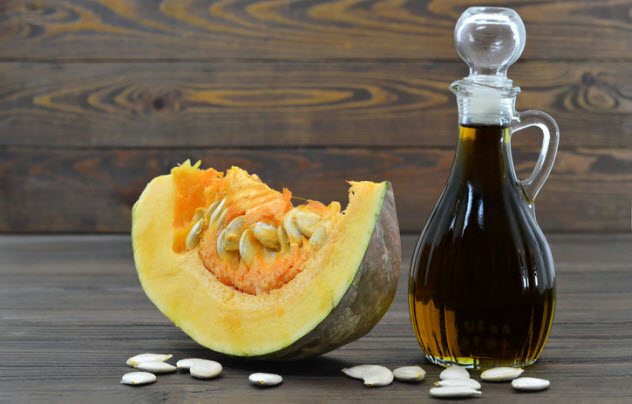
Pumpkin seed oil comes from the Styrian pumpkin, a variety grown in southeast Austria and nearby countries. It is a popular salad dressing with a unique trait: The oil can look green or red depending on oil film thickness. This phenomenon is called dichromatism. Long considered a mystery, it was only unraveled in 2007.
Of the three characteristics of color, saturation and brightness are determined by the thickness and concentration of liquids, such as paint. Hue, however, is fixed by the material properties of the liquid. For example, blood is red because of its hemoglobin. Though it might be crimson if pure and lighter red if diluted with water, it will never be green.[8]
However, pumpkin seed oil can have either color due to the unique ranges of light it absorbs and the differing color sensitivities of the human eye. When white light passes through pumpkin seed oil, it absorbs all colors except for a wide range of wavelengths around 520 nanometers (green) and a much narrower range around 650 nanometers (red). However, it soaks up green much more strongly than red, which means that the red is brighter even though fewer red wavelengths come out.
When light passes through a thin layer of oil, a wider range of green wavelengths go through. But the intensities of red and green are only slightly muted because light absorption increases with layer thickness. This, and the fact that human eyes have a greater sensitivity to green (so green appears brighter than an equally bright shade of red), makes the oil seem green.
When light passes through a thick layer of oil, a greater amount of green than red wavelengths are transmitted. But the intensity of green drops much more than red. Therefore, the color is much dimmer, to the point that even the human eye’s greater sensitivity to green cannot increase its apparent brilliance. Thus, the pumpkin seed oil looks red.
2 Pumpkin Alcohol
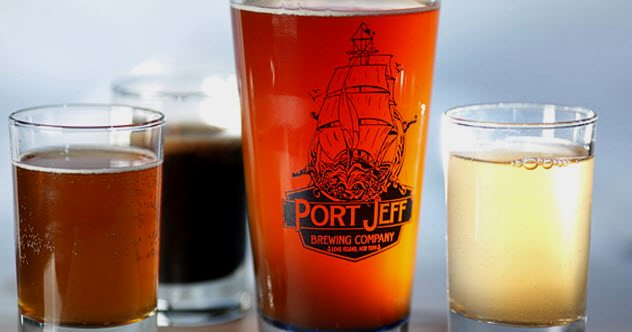
Yeasts are an essential ingredient for making beer because they eat sugars and make carbon dioxide and alcohol as waste products. Their primary food is often malt, made from sprouted barley.
In colonial New England, good malt was not readily available. Colonists had to make do with other sources of fermentable sugars, such as pumpkins.
Pumpkin flesh took the place of the malt entirely. As a result, pumpkin ale of the colonial era was said to have a noticeable “tang” unless aged for a few years.[9] Pumpkin beer was brewed throughout the 18th century, but became less popular by the 19th century.
In 1995, pumpkin beers became a craft beer specialty. Indeed, there are now so many kinds that Seattle’s Elysian Brewing has a pumpkin beer festival with many beers in various styles.
Pumpkin is used only for flavor in these modern beers. Most brewers use canned pumpkin, so the puree might not come from Halloween-standard pumpkins. The pumpkin can be mashed, but most brewers say they get better flavor with less trouble by simply adding it to the boil.
Unlike historical pumpkin ales, modern pumpkin beers are often spiced with “pumpkin pie” spices. In fact, most of the flavor of so-called pumpkin ales comes from the spices, as the pumpkin flavor is otherwise subtle.
1 The First Thanksgiving Had No (Real) Pie
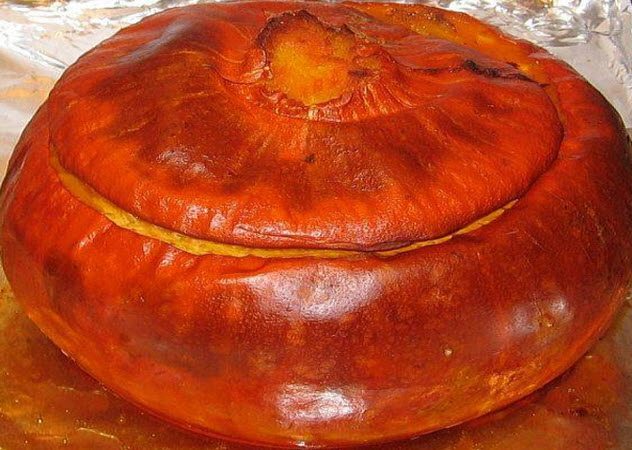
Most authorities agree that there was no pumpkin pie at the first (or second) Thanksgiving. Others, however, claim that there was. The debate comes from how one defines “pie.”
The first “pumpkin pie” was very different from the modern version. It was made by slicing off the top of a mature pumpkin (probably C. pepo), removing the seeds, and filling the inside with milk, spices, and honey. Then the pumpkin was baked in hot ashes.[10]
Pumpkin pie as people imagine it today (a sweetened pumpkin custard in a pastry crust) was not talked about until America’s first cookbook, American Cookery, was published in 1796 just after America gained its independence.
In 1827, Sarah Josepha Hale, the primary advocate for making Thanksgiving a national holiday, claimed that pumpkin pie was “an indispensable part of a good and true Yankee Thanksgiving.” It was only by the 1800s that pumpkin pie had become widely associated with the colonial period and a definite part of the Thanksgiving meal.
Jenn Dandy likes biology, parasites, Pokemon, and high-quality cartoons. Her Tumblr blog is here.
Read about weird and spooky Halloween traditions on 10 Creepy Rituals We Once Used To Celebrate Halloween and 10 Things You Didn’t Know About The History Of Halloween.








